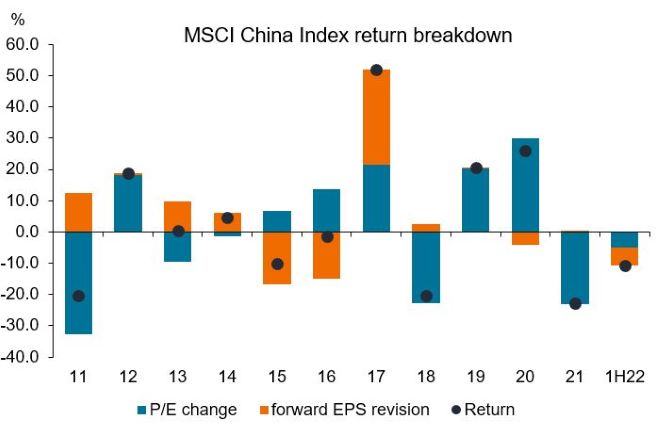Subscribe
Sign up for timely perspectives delivered to your inbox.
Portfolio manager May Ling Wee discusses why, following a period of market weakness, Chinese stocks are now looking more appealing to investors.

Chinese stocks have suffered since the start of 2022 following the Chinese government’s insistence on continuing with its ‘Zero COVID’ policy, which caused significant economic fallout. The slowdown has been acute, manifested in weaker employment, weak consumer spending, and a property market still in the doldrums.
But looking at the numbers, after a poor first quarter, China’s equity market outperformed developed markets as a whole as well as emerging markets in the second quarter of the year1. Is investor sentiment towards China turning a corner?
China’s strict COVID regulations put a significant strain on the economy and policymakers are now facing up to the economic reality of lockdowns. Bucking the global tightening trend, China’s policy easing could sustain market outperformance into the remainder of 2022. The government’s deployment of fiscal and monetary policy appears to be in earnest. Financial institutions have been urged to lend again, funding for infrastructure projects is being ramped up, while various tax initiatives have been announced, eg. purchase sales tax has been halved for passenger vehicles, and social insurance payments have been deferred for small and medium-sized enterprises (SMEs).
Other incrementally positive signs for investors include the refining of COVID guidelines with shorter quarantine periods, the  simplification of the travel QR code system and continuing to ensure supply chains and production are given priority. The technology sector, which bore the brunt of the China market sell-off since early 2021, has seen some reprieve, with the government shift to managing growth and stability instead of preventing the “disorderly expansion of capital”.
simplification of the travel QR code system and continuing to ensure supply chains and production are given priority. The technology sector, which bore the brunt of the China market sell-off since early 2021, has seen some reprieve, with the government shift to managing growth and stability instead of preventing the “disorderly expansion of capital”.
China’s huge domestic market remains a key reason for investors to invest in the region. Consumer sentiment should improve when COVID restrictions ease further. This improvement in mobility should eventually lead to an improving services and SME sector, which would help employment. Among the segments that could benefit include internet platforms, small-ticket consumer discretionary segments such as food & beverage, domestic travel, and hotel stays. Market weakness this year has led to some value opportunities in select large internet platforms, life insurers, consumer-focused banks, infrastructure-related companies, and specific healthcare companies.
While macroeconomic data is stabilising, current company earnings and guidance will likely be revised when first-half earnings reports are released in August. The chart shows the return for the MSCI China Index by calendar year, which is driven by a combination of forward earnings per share (EPS) revisions and the change (either expansion or contraction) in the price-to-earnings (P/E) multiple of companies within the index. The P/E multiple can be thought of as what the market is prepared to pay to access earnings, typically affording a higher multiple when sentiment towards equities is more positive and financing costs are lower. Investors should take note that any rebound this year is likely to be comparatively weaker than the post-COVID period in 2020 or the growth spurt in 2017, given the current backdrop of monetary tightening in developed markets and weak global demand, exacerbated by higher energy prices and input costs.
 Source: Bloomberg Finance LP, FactSet, Janus Henderson Investors. Macquarie Macro Strategy Global/Greater China 28 June 2022. P/E change refers to expansion/contraction of the P/E multiple (current share price divided by earnings per share). Forward EPS refers to analysts’ estimates of profitability per share for the following 12 months from a given date.
Source: Bloomberg Finance LP, FactSet, Janus Henderson Investors. Macquarie Macro Strategy Global/Greater China 28 June 2022. P/E change refers to expansion/contraction of the P/E multiple (current share price divided by earnings per share). Forward EPS refers to analysts’ estimates of profitability per share for the following 12 months from a given date.Nonetheless, we are heartened by signs of economic reopening, policy easing and softer private sector regulation, which we believe could entice investment flows back to China.
1 MSCI China, MSCI World, MSCI Emerging Markets indices price returns in US dollars, year-to-date to 30 June 2022. Past performance does not predict future returns.
Earnings per share (EPS): the portion of a company’s profit attributable to each share in the company. It is calculated by dividing profits (after tax) by the number of shares.
Price-to-earnings (P/E): a popular ratio used to value a company’s shares, compared to other stocks, or a benchmark index. It is calculated by dividing the current share price by its earnings per share.
Policy easing: monetary easing refers to a central bank increasing the supply of money and lowering borrowing costs, while fiscal stimulus refers to an increase in government spending and/or a reduction in taxes policy.
Policy tightening: monetary tightening refers to central bank activity aimed at curbing inflation and slowing down growth in the economy by raising interest rates and reducing the supply of money. Fiscal contraction refers to raising taxes and/or cutting spending to reduce government debt.
MSCI China Index: captures large and mid cap representation across China A shares, H shares, B shares, Red chips, P chips and foreign listings.